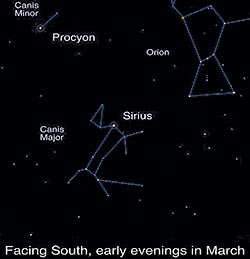DARK SKY HAPPENINGS - March 2021
This article is distributed by NASA Night Sky Network by David Prosper
March skies feature many dazzling stars and constellations, glimmering high in the night, but two of the brightest stars are the focus of our attention this month: Sirius and Procyon, the dog stars! Near Sirius -around the width of a hand with fingers spread out, held away at arm’s length -you’ll find Procyon, the 8th brightest star in the night sky. Procyon is another one of our Sun’s closest neighbors, though a little farther away than Sirius, 11.5 light years away. While less massive than Sirius, it is much older and unusually luminous for a star of its type, leading astronomers to suspect that it may “soon” –at some point millions of years from now –swell into a giant star as it nears the end of its stellar life. Sirius and Procyon are nicknamed the “Dog Stars,” an apt name as they are the brightest stars in their respective constellations –Canis Major and Canis Minor –whose names translate to “Big Dog” and ”Little Dog.” Not everyone sees them as canine companions. As two of the brightest stars in the sky, they feature prominently in the sky stories of cultures around the world. Sirius also captures the imaginations of people today: when rising or setting near the horizon, its brilliance mixes with our atmosphere’s turbulence, causing the star’s light to shimmer with wildly flickering color. This vivid, eerie sight was an indication to ancient peoples of changes in the seasons, and even triggers UFO reports in the modern era! Both of these bright stars have unseen companions: tiny, dense white dwarf stars, the remnants of supermassive companion stars. Careful observations of these nearby systems over hundreds of years have helped advance the fields of: astrometry, the precise measurement of stars; stellar evolution; and astroseismology, the study of the internal structure of stars via their oscillations.
MOON HAPPENINGS
|

